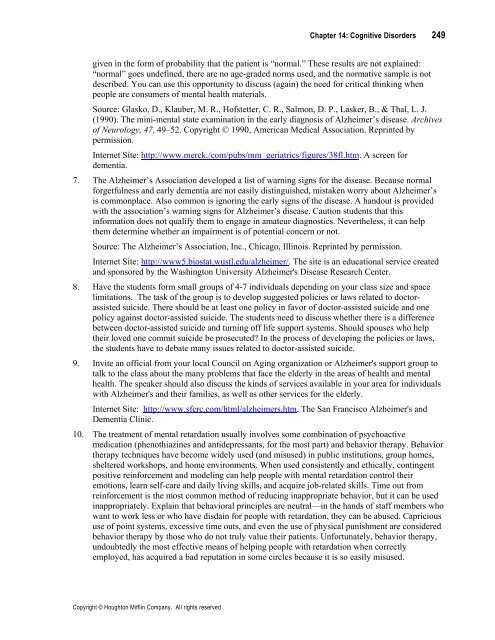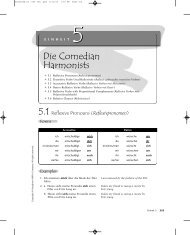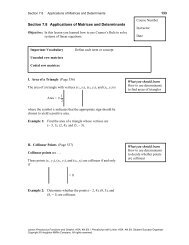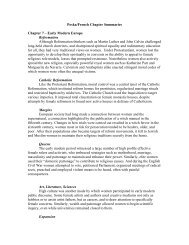Understanding Abnormal Behavior - Cengage Learning
Understanding Abnormal Behavior - Cengage Learning
Understanding Abnormal Behavior - Cengage Learning
You also want an ePaper? Increase the reach of your titles
YUMPU automatically turns print PDFs into web optimized ePapers that Google loves.
Copyright © Houghton Mifflin Company. All rights reserved.<br />
Chapter 14: Cognitive Disorders 249<br />
given in the form of probability that the patient is “normal.” These results are not explained:<br />
“normal” goes undefined, there are no age-graded norms used, and the normative sample is not<br />
described. You can use this opportunity to discuss (again) the need for critical thinking when<br />
people are consumers of mental health materials.<br />
Source: Glasko, D., Klauber, M. R., Hofstetter, C. R., Salmon, D. P., Lasker, B., & Thal, L. J.<br />
(1990). The mini-mental state examination in the early diagnosis of Alzheimer’s disease. Archives<br />
of Neurology, 47, 49–52. Copyright © 1990, American Medical Association. Reprinted by<br />
permission.<br />
Internet Site: http://www.merck./com/pubs/mm_geriatrics/figures/38fl.htm. A screen for<br />
dementia.<br />
7. The Alzheimer’s Association developed a list of warning signs for the disease. Because normal<br />
forgetfulness and early dementia are not easily distinguished, mistaken worry about Alzheimer’s<br />
is commonplace. Also common is ignoring the early signs of the disease. A handout is provided<br />
with the association’s warning signs for Alzheimer’s disease. Caution students that this<br />
information does not qualify them to engage in amateur diagnostics. Nevertheless, it can help<br />
them determine whether an impairment is of potential concern or not.<br />
Source: The Alzheimer’s Association, Inc., Chicago, Illinois. Reprinted by permission.<br />
Internet Site: http://www5.biostat.wustl.edu/alzheimer/. The site is an educational service created<br />
and sponsored by the Washington University Alzheimer's Disease Research Center.<br />
8. Have the students form small groups of 4-7 individuals depending on your class size and space<br />
limitations. The task of the group is to develop suggested policies or laws related to doctorassisted<br />
suicide. There should be at least one policy in favor of doctor-assisted suicide and one<br />
policy against doctor-assisted suicide. The students need to discuss whether there is a difference<br />
between doctor-assisted suicide and turning off life support systems. Should spouses who help<br />
their loved one commit suicide be prosecuted? In the process of developing the policies or laws,<br />
the students have to debate many issues related to doctor-assisted suicide.<br />
9. Invite an official from your local Council on Aging organization or Alzheimer's support group to<br />
talk to the class about the many problems that face the elderly in the areas of health and mental<br />
health. The speaker should also discuss the kinds of services available in your area for individuals<br />
with Alzheimer's and their families, as well as other services for the elderly.<br />
Internet Site: http://www.sfcrc.com/html/alzheimers.htm. The San Francisco Alzheimer's and<br />
Dementia Clinic.<br />
10. The treatment of mental retardation usually involves some combination of psychoactive<br />
medication (phenothiazines and antidepressants, for the most part) and behavior therapy. <strong>Behavior</strong><br />
therapy techniques have become widely used (and misused) in public institutions, group homes,<br />
sheltered workshops, and home environments. When used consistently and ethically, contingent<br />
positive reinforcement and modeling can help people with mental retardation control their<br />
emotions, learn self-care and daily living skills, and acquire job-related skills. Time out from<br />
reinforcement is the most common method of reducing inappropriate behavior, but it can be used<br />
inappropriately. Explain that behavioral principles are neutral—in the hands of staff members who<br />
want to work less or who have disdain for people with retardation, they can be abused. Capricious<br />
use of point systems, excessive time outs, and even the use of physical punishment are considered<br />
behavior therapy by those who do not truly value their patients. Unfortunately, behavior therapy,<br />
undoubtedly the most effective means of helping people with retardation when correctly<br />
employed, has acquired a bad reputation in some circles because it is so easily misused.

















